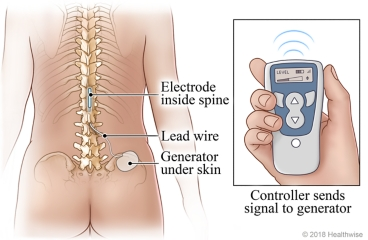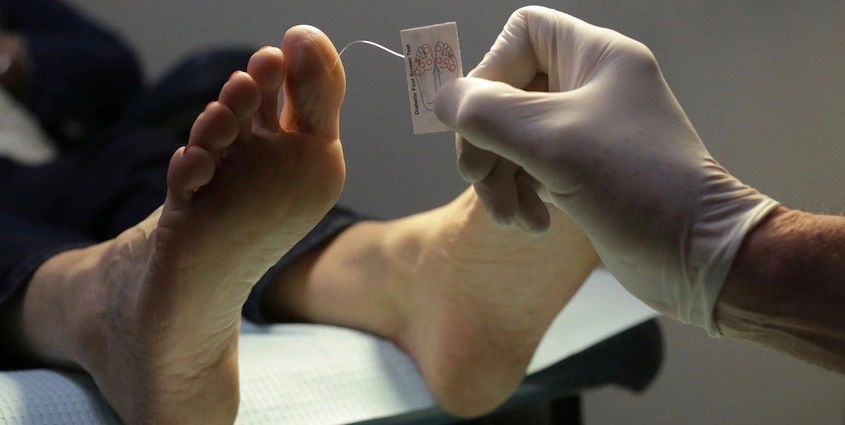
If you’re living with diabetes and dealing with nagging leg pain, you’re not alone. Many people with diabetes struggle with pain, numbness, or cramping in their legs—often unsure of what’s causing it or how to get relief. The good news? You don’t have to just live with it. Understanding the cause of your leg pain can help you find the right treatment and get back to doing the things you love.
Let’s walk through the most common reasons why diabetes causes leg pain and what you can do about it.
Nerve Damage: The #1 Cause of Diabetes Leg Pain
For most people with diabetes, leg pain starts with the nerves. The most common condition behind this pain is called diabetic peripheral neuropathy, specifically distal symmetric polyneuropathy. It usually begins in the feet and gradually works its way up the legs in a pattern that doctors describe as “stocking-like.”

The pain may feel like burning, tingling, or sharp zaps. Sometimes, it’s numbness or a strange sense of pressure, as if your foot is wrapped in cotton. Often, the pain is worse at night and can affect sleep and daily movement.
The American Diabetes Association recommends a yearly foot and nerve screening if you’ve had type 2 diabetes—or type 1 for more than five years. These tests are simple and quick, using things like a soft monofilament or tuning fork.
Managing this type of nerve pain starts with blood sugar control. The better your A1c, the slower the nerve damage tends to progress. But even with good control, some people still develop symptoms. That’s where medications like gabapentin, duloxetine, or pregabalin come in. These can take the edge off the pain and make daily life a lot more manageable.
For patients with persistent, severe pain that doesn’t improve with medication, spinal cord stimulation can be a life-changing option. This minimally invasive treatment uses mild electrical pulses to interrupt pain signals before they reach the brain. Many people with painful diabetic neuropathy find long-lasting relief and improved function with this therapy, especially when other treatments have failed.

When Poor Circulation Is the Problem
Not all leg pain in diabetes is due to nerves. Sometimes, it’s actually about blood flow. If walking even short distances causes aching or cramping in your calves or thighs—and that pain goes away when you rest—you may be dealing with Peripheral Arterial Disease, or PAD.
PAD happens when the blood vessels in your legs become narrowed or blocked. It can cause fatigue, heaviness, or burning during activity. The pain often returns in the same spot every time you walk a certain distance.
Doctors can check for PAD using a painless test called the ankle-brachial index (ABI), which compares blood pressure in your arms and ankles. If caught early, PAD can often be managed with medications, exercise, and sometimes procedures to open up the arteries.
Could It Be Coming from Your Back?
If your leg pain travels down just one leg, especially below the knee, it could be something else entirely: lumbar radiculopathy, more commonly known as sciatica. This kind of pain usually comes from a pinched nerve in your lower spine. It might shoot down your thigh, wrap around your shin, or even feel like pins and needles in your toes.
While not as common in people with diabetes as neuropathy or PAD, it’s still worth considering—especially if your leg pain seems linked to certain movements, or if it’s paired with weakness or numbness. In these cases, an MRI may be needed to pinpoint the issue.
Other Reasons for Leg Pain in Diabetes
Leg pain can come from a variety of sources, and sometimes it’s more than one thing at the same time.
If your knees or hips feel stiff and sore—especially after activity—you might be dealing with osteoarthritis, which is more common in people with diabetes. This kind of pain typically eases with rest and may feel worse after sitting or standing for long periods.
There’s also a lesser-known but serious condition called diabetic amyotrophy. It comes on suddenly with intense pain in one thigh or hip and often leads to muscle weakness and unintentional weight loss. Although rare, it’s important to recognize early and manage with physical therapy, medications, and supportive care.
And don’t forget about medications. If you’re taking a statin for cholesterol, you may develop statin-associated muscle pain, often felt in the upper legs or hips. It usually shows up as a dull ache or weakness and may be confirmed by checking blood levels of creatine kinase (CK).
When It Might Be Something More Urgent
Some causes of diabetes leg pain require immediate attention. If your leg suddenly becomes cold, pale, or numb—and you’re unable to move your foot—it could be acute limb ischemia, a medical emergency caused by a blocked artery.
Another emergency is necrotizing fasciitis, a fast-moving infection of the soft tissues. This condition causes extreme pain, redness, swelling, and often fever or chills. If it’s not treated quickly with surgery, it can be life-threatening.
Deep vein thrombosis (DVT) is also on the list of dangerous possibilities. It often causes swelling and pain in just one leg and can happen after long periods of sitting or travel. A simple ultrasound can diagnose it, and blood thinners are usually needed.
Getting to the Root of the Pain
Diagnosing leg pain in someone with diabetes isn’t always straightforward. That’s why it’s so important to look at the big picture. Doctors will ask when the pain started, whether it worsens with walking or rest, and whether there are other symptoms like numbness, skin changes, or weakness.
They’ll likely do a combination of tests—like a foot exam with a monofilament to check nerve function, an ABI to check circulation, blood work to rule out muscle damage, and possibly imaging like an MRI or ultrasound depending on what they find.

You Don’t Have to Live with Diabetes Leg Pain
Leg pain can rob you of sleep, mobility, and peace of mind. But with the right diagnosis and a personalized treatment plan, relief is possible.
At Red Butte Pain Solutions, we specialize in helping people with diabetes leg pain, whether it’s caused by nerve damage, poor circulation, spine issues, or something else. We use a combination of advanced testing and targeted therapies to get you feeling better faster.
If you’re in Chandler, Mesa, Gilbert, Sun Lakes, Casa Grande, or Maricopa, we’d love to help.
Schedule a consultation today or call us at 602-633-4334 to start your journey toward pain relief.
